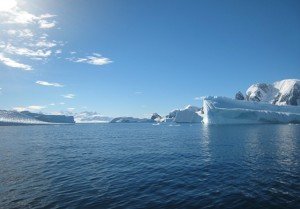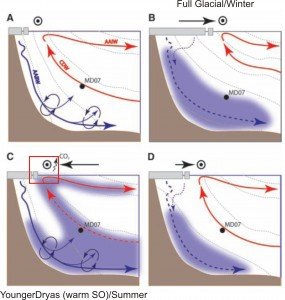 Ice core records show there was a sharp rise in carbon dioxide in the atmosphere — a nearly 50% increase — at the end of the last ice age. Scientists have long puzzled over the origin of all the extra CO2 that appeared as the great ice sheets melted.
Ice core records show there was a sharp rise in carbon dioxide in the atmosphere — a nearly 50% increase — at the end of the last ice age. Scientists have long puzzled over the origin of all the extra CO2 that appeared as the great ice sheets melted.
Now, new evidence published in Science (with accompanying Perspective) confirms that the gas emerged largely from the deep waters of the Southern Ocean as changes to ocean currents and circulation disrupted an enormous carbon sink there.
Scientists looked at radiocarbon levels in the shells of microscopic animals which lived both near the surface and on/near the bottom of the Southern Ocean, and found large quantities of carbon locked away in ‘old deep water’ around Antarctica. The dissolved CO2 accumulated as organic matter died and sank to the ocean floor. Around 19,000 years ago, when the largest ice sheets starting melting, current and circulation changes brought this deep water up to the surface, in the process releasing large amounts of CO2 into the atmosphere.
The Science Media Centre approached local experts to find out what they think of the finding, and the papers can be accessed in the SMC Resource Library.
Dr Giuseppe Cortese, New Zealand IODP Coordinator of the Paleontology and Environmental Change Section at GNS Science, comments:
“During glacials, the biological pump in the Southern Ocean is more efficient than today. This is a response to higher iron availability in glacials, linked to higher atmospheric dust input to the ocean. This makes the glacial Southern Ocean an even bigger carbon sink than what is observed today.
“To explain in a little more detail: Biology-driven processes in the Southern Ocean (e.g., biological pump efficiency) make this area potentially an even bigger sink than what is described in the article, which focusses on physical processes (i.e., upwelling of “old” deep water). Microplankton produced in the surface ocean during spring/summer blooms are exported to the deep ocean (the so called “biological pump”), thus storing away, long-term over timescales of thousands of years, large amounts of organic matter/CO2. This process is working at less than optimal levels right now, due to micronutrient (iron) limitation in the Southern Ocean, and can be substantially boosted by increased availability of iron in the surface ocean. This increased availability of iron occurs in connection to increased atmospheric dust transport during glacials, or (at a seasonal scale) during sea ice retreat during spring/summer.
 “This is particularly important at the Antarctic Polar Front (red boxed area in the scheme, the area where the “old”, CO2-rich waters described in the article upwell to the surface and release CO2 to the atmosphere), where an enormous amount of biological production takes place in late spring/summer. The export towards the deep ocean of this organic matter, at the end of the bloom, tends to counteract the effect of CO2 degassing due to deep water upwelling. Interestingly, in the Seasonally Ice-free Zone (SIZ, the band located between the winter and summer sea ice edge), this production is highly stimulated by increased iron availability due to the seasonal sea ice retreat.
“This is particularly important at the Antarctic Polar Front (red boxed area in the scheme, the area where the “old”, CO2-rich waters described in the article upwell to the surface and release CO2 to the atmosphere), where an enormous amount of biological production takes place in late spring/summer. The export towards the deep ocean of this organic matter, at the end of the bloom, tends to counteract the effect of CO2 degassing due to deep water upwelling. Interestingly, in the Seasonally Ice-free Zone (SIZ, the band located between the winter and summer sea ice edge), this production is highly stimulated by increased iron availability due to the seasonal sea ice retreat.
“All these processes give a taste of the complex interaction between sea ice, biological productivity, and deep water upwelling as mechanisms controlling CO2 outgassing in the Southern Ocean, particularly at the Antarctic Polar Front, where they are strongly coupled.”
Dr Nancy Bertler*, Senior Research Fellow at the Antarctic Research Centre at Victoria University of Wellington, comments:
“The paper by Skinner provides important evidence the Southern Ocean is at least a substantial source of the CO2 increase (by showing a 50% decrease of 14C in the atmospheric CO2), which is a critical piece of the puzzle when trying to understand, model, and quantify the CO2 source/sink behaviour of the Southern Ocean in a warming world today and in the future.
“Skinner at all then argue that the oceans transmitted the signal from the warming North (Milancovitch) to the South (by shutting down the Meridional Overturning Circulation (MOC) – heat remains in the Southern Hemisphere, which would melt sea-ice, which leads to more mixing/upwelling of the deep ocean as the ocean is not ‘protected’ by sea-ice anymore).
“Anderson and Carr [in the Perspective] discuss in addition an alternative process, which is similar to Hai et al. suggesting that a southward shift of the Intertropical Convergence Zone would either push the westerlies in the South further south, or would strengthen them. Either way, stronger wind action around Antarctica would lead to more mixing/upwelling of the deep ocean as well. While both lead to the same result, it is important to distinguish between them, to not only empirically observe but to understand the processes.
“This is important, as Greenland (and West Antarctica) is currently melting “again” which could lead to slowing of the MOC (due to fresh water input into the North Atlantic from Greenland). Hence there is a chance that Southern Ocean could amplify the warming trend by releasing CO2 as it did during deglaciation.
“New Zealand has a number of key efforts to improve our understanding on the involved sequence of events, the thresholds, and processes – for example:
- ANDRILL (PI Prof. Tim Naish Victoria University, Dr. Richard Levy GNS Science)
- ANZICE (Antarctica-New Zealand Interglacial Climate Extremes) seeks to understand the likely response of the New Zealand – Antarctic region to a warmer world. (PI Prof. Lionel Carter, Victoria University)
- GCT (Global Change Through Time) the programme will focus on improving predictions of future progressive or abrupt warming, improving predictions of future climate variability, and improving understanding of the carbon cycle (PI Dr. James Crampton, GNS Science)
- NZ INTIMATE (INTegration of Ice-core, MArine and TEerrestrial records), which is a core programme of the INQUA (International Union for Quaternary Research) Palaeoclimate Commission (PALCOMM). Dr. Marcus Vandergoes (GNS Science) is currently leading the NZ INTIMATE group which has participants from all universities, GNS Science, and NIWA.”
Dr Philip Boyd, of the NIWA Centre of Chemical & Physical Oceanography at the University of Otago, comments:
“We could also say that this new study further reinforces the disproportionate importance of the Southern Ocean in modulating global climate both in the geological past, present day, and in the future. In addition, the authors provide compelling evidence of both the important coupling of ocean and atmosphere processes and the strong communication, of effects of climatic change, between the waters of the Northern and Southern hemisphere through global ocean circulation.”
—————————
*Additional background from Nancy Bertler:
Hai and colleagues (Hai Cheng, R. Lawrence Edwards, Wallace S. Broecker, George H. Denton, Xinggong Kong, Yongjin Wang, Rong Zhang, and Xianfeng Wang (9 October 2009): Ice Age Terminations . Science 326 (5950), 248. [DOI: 10.1126/science.1177840]) correlated speleotherm, ice core, and marine records to show a sequence of events that led to termination of glacials in the past:
1.
Solar radiation received by the Earth increases due to orbital forcing (Milancovitch theory)
2.
This causes slightly warmer summers in the Northern Hemisphere
3.
This causes the Northern Hemisphere ice sheets to melt in summer
4.
The input of melted ice into the ocean slows (or shuts down) the thermohaline circulation (or Meridional Overturning Circulation), which further freshens the North Atlantic
5.
This increases sea-ice in the North Atlantic and very cold conditions in Eurasia during winter
6.
This leads to weaker Monsoons in the following summer. The link is still debated but it is possible that simple the extensive snow cover during the cold winters in Europe and Asia delay the continental warming in summer which is the engine of the monsoon. With that the monsoon moves southward and with that the tropical rain belt.
7.
The slowing (or shut down) of the MOC leads the Southern Hemisphere to retain heat (which otherwise would have been exported to the North)
8.
This occurs as the same time as CO2 and sea-level rise
9.
It has been suggested that the rise in CO2 had to come from the Southern Ocean (as seen in higher krypton and xenon values in the atmosphere (Severinghaus et al. 2009, Southern see-saw seen. Nature, News and Views, v. 457, p.1093-1094 and Baker et al. same issue, p.1097-1102). This could be caused either by less ocean stratification or less Antarctic sea-ice – but there was no proof.